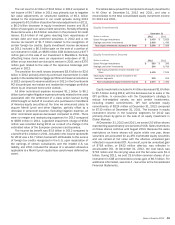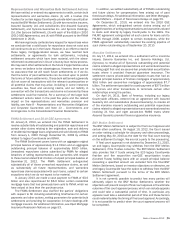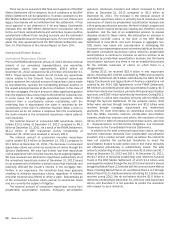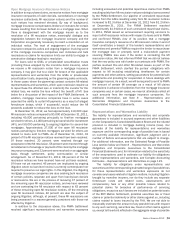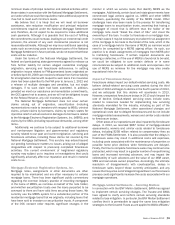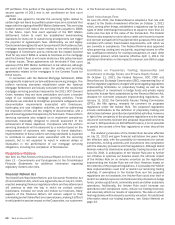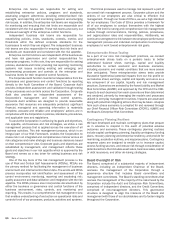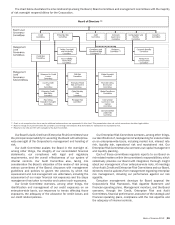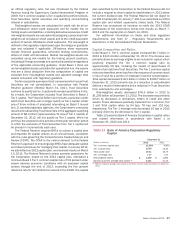Bank of America 2012 Annual Report Download - page 60
Download and view the complete annual report
Please find page 60 of the 2012 Bank of America annual report below. You can navigate through the pages in the report by either clicking on the pages listed below, or by using the keyword search tool below to find specific information within the annual report.58 Bank of America 2012
the control of the servicer; although, we believe that the governing
contracts, our course of dealing, and collective past practices and
understandings should inform resolution of these matters. In
addition, many non-agency RMBS and whole-loan servicing
agreements state that the servicer may be liable for failure to
perform its servicing obligations in keeping with industry standards
or for acts or omissions that involve willful malfeasance, bad faith
or gross negligence in the performance of, or reckless disregard
of, the servicer’s duties.
It is not possible to reasonably estimate our liability with
respect to potential servicing-related claims. While we have
recorded certain accruals for servicing-related claims, the amount
of potential liability in excess of existing accruals could be material.
In October 2010, we voluntarily stopped taking residential
mortgage foreclosure proceedings to judgment in states where
foreclosure requires a court order following a legal proceeding
(judicial states) and stopped foreclosure sales in all states in order
to complete an assessment of related business processes. We
have resumed foreclosure sales in all states, but our progress on
foreclosure sales in judicial states has been much slower than in
states where foreclosure does not require a court order (non-
judicial states).
2011 OCC Consent Order and 2013 IFR Acceleration
Agreement
We entered into the 2011 OCC Consent Order on April 13, 2011.
This consent order required servicers to make several
enhancements to their servicing operations, including
implementation of a single point of contact model for borrowers
throughout the loss mitigation and foreclosure processes,
adoption of measures designed to ensure that foreclosure activity
is halted once a borrower has been approved for a modification
unless the borrower fails to make payments under the modified
loan and implementation of enhanced controls over third-party
vendors that provide default servicing support services. In
addition, the 2011 OCC Consent Order required that we retain an
independent consultant, approved by the OCC, to conduct a review
of all foreclosure actions pending, or foreclosure sales that
occurred, between January 1, 2009 and December 31, 2010 and
submit a plan to the OCC to remediate all financial injury to
borrowers caused by any deficiencies identified through the review.
On January 7, 2013, we and other mortgage servicing institutions
entered into the 2013 IFR Acceleration Agreement with the Federal
Reserve and the OCC to cease the case-by-case IFR program
created by the 2011 OCC Consent Order and replace it with an
accelerated remediation process. The 2013 IFR Acceleration
Agreement requires us to make a cash payment of $1.1 billion
and provide $1.8 billion of borrower assistance in the form of loan
modifications and other foreclosure prevention actions. The
borrower assistance program is not expected to result in any
incremental credit provision, as we believe that the existing
allowance for credit losses is adequate to absorb any costs that
have not already been recorded as charge-offs.
National Mortgage Settlement
In March 2012, we entered into settlement agreements
(collectively, the National Mortgage Settlement) with (1) the U.S.
Department of Justice, various federal regulatory agencies and 49
state Attorneys General to resolve federal and state investigations
into certain residential mortgage origination, servicing and
foreclosure practices, (2) HUD to resolve certain claims relating
to the origination of FHA-insured mortgage loans, primarily by
Countrywide prior to and for a period following our acquisition of
that lender, and (3) each of the Federal Reserve and the OCC
regarding civil monetary penalties related to conduct that was the
subject of consent orders entered into with the banking regulators
in April 2011. The National Mortgage Settlement was entered by
the court as a consent judgment on April 5, 2012. The National
Mortgage Settlement provided for the establishment of certain
uniform servicing standards, upfront cash payments of
approximately $1.9 billion to the state and federal governments
and for borrower restitution, approximately $7.6 billion in borrower
assistance in the form of, among other things, credits earned for
principal reduction, short sales, deeds-in-lieu of foreclosure and
approximately $1.0 billion of credits earned for interest rate
reduction modifications. In addition, the settlement with HUD
provided for an upfront cash payment of $500 million to settle
certain claims related to FHA-insured loans. We will also be
obligated to provide additional cash payments of up to $850 million
if we fail to earn an additional $850 million of credits stemming
from incremental first-lien principal reductions over a three-year
period.
The borrower assistance program did not result in any
incremental credit provision during 2012, as we believe that the
existing allowance for credit losses is adequate to absorb any
costs that have not already been recorded as charge-offs. The
interest rate modification program consisted of interest rate
reductions on first-lien loans originated prior to January 1, 2009
that have a current loan-to-value (LTV) ratio greater than 100
percent and that meet certain eligibility criteria, including the
requirement that all payments due for the last twelve months have
been made in a timely manner. This program commits us to forego
future interest payments that we may not otherwise have agreed
to forego, and no loss has been recognized in the financial
statements related to such forgone interest. Modifications of
approximately 7,500 loans with an aggregate unpaid principal
balance of $2.1 billion providing for an average interest rate
reduction of approximately two percent were completed as of
December 31, 2012, resulting in an estimated decrease in fair
value of the modified loans of approximately $242 million. The
interest rate modification program is expected to include
approximately 20,000 to 25,000 loans with an aggregate unpaid
principal balance of $5.4 billion to $6.8 billion. Assuming an
average interest rate reduction of approximately two percent, the
modifications are expected to result in a reduction of annual
interest income of approximately $100 million to $130 million
when the program is complete. Assuming a weighted-average loan
life of approximately eight years, the fair value of loans in the
program is expected to decrease by approximately $600 million
to $800 million as a result of the interest rate reductions. The
financial impact will vary depending on final terms of modifications
offered and the rate of borrower acceptance. We do not expect
loans modified under the program to be accounted for as troubled
debt restructurings (TDRs). If the program is expanded to include
loans that do not meet specified underwriting criteria, such as
maximum debt-to-income ratios or minimum FICO scores, the
modifications of such loans will be accounted for as TDRs.
We could be required to make additional payments if we fail to
meet our borrower assistance and rate reduction modification
commitments over a three-year period, in an amount equal to 125
percent to 140 percent of the shortfall, dependent on the two- and
three-year commitment target. We also entered into agreements
with several states under which we committed to perform certain



